A dish that tastes like an old book, soon available at the Roca brothers’ El Celler de Can Roca? There is a whole story behind it, which we’re going to tell you.
Capturing scents. Transforming them from volatile into more tangible substances. Distilling their essence, turning them into something solid - no, liquid - that fully reflects their identity, but in a different form. Making them, in this way, edible. This is a dream that the Rocas have pursued for a long time. They got the urge to try years ago, when they had a pot on the cooker in which a truffle broth was simmering. The air was full of the smell of the tuber: but they saw the vapours of this broth being sucked up by the hood and thought that somehow this dispersed some of its essence. It was like subtracting the aromatic fullness of that broth. Could they capture that escaping smell? They set to work.
In particular, Jordi Roca - the youngest of the tres hermanos, the 'sweet' mind - began experimenting. He would later create desserts incorporating Dior’s eau de parfum de Chanel. But that was not enough: his goal became to include the very soul of what they were cooking into perfumed water. Meanwhile, with Joan and Josep, he tried a traditional copper still and distilled shrimp heads, but the result was not as expected: the direct heat toasted the crustacean, thus interfering with the final result.
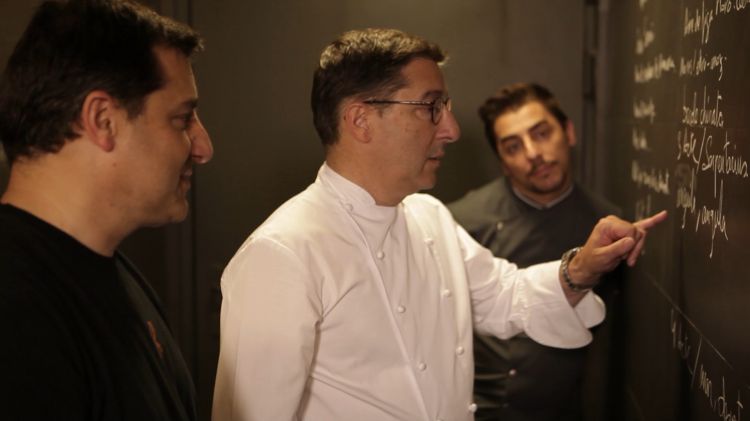
The three brothers Josep, Joan and Jordi Roca
In short, they needed a lower-temperature distiller. In 2005 the
Rotaval was born. It’s a rotary evaporator that incorporates the vacuum technique. By removing the air and modifying atmospheric pressure, they lowered the boiling temperature so that a between 50 and 70°C was enough to capture an aromatised vapour and thus the same pure aroma, ready to be condensed into a liquid. The
Rocas began to propose distillates of earth, leather, wood... Lots of them in their dishes (one of the earliest examples was
La Luna, which tastes just like a truffle and earth distillate: they had solved their initial problem!).
The next step, and the one that brings us to the present day, took place in 2016. To further expand the boundaries of his research, Jordi Roca took up an ancient technique, enfleurage. It dates back to the Ancient Egyptians and was used for millennia to extract fragrances from flower petals, the most delicate part of the plant, which does not tolerate high-temperature processing, because it would denature the final product. With enfleurage, the fragrance - i.e. the essential oils - of roses, jasmine, tuberoses, violets, orange blossom and many others is fixed by transferring it into a solvent, usually a solid fat. So why not use the same method in other fields?
Jordi Roca was particularly fascinated by the smell of books, the old ones, the ones you might find in a library. Therefore, he thought of something extraordinary: distilling that scent. How? Precisely through enfleurage and Rotaval. Jordi explains: 'Choose a book that smells of mature paper, spread a deodorised butter on the pages and let it sit overnight so that the butter itself becomes imbued with the smell of the old book. The next morning, remove that butter with a spatula to dissolve it in alcohol, then distil it all [with the Rotaval, i.e. always through 'light' distillation] so the alcohol evaporates. This way, we will have an 'absolute' perfume of an old book'.
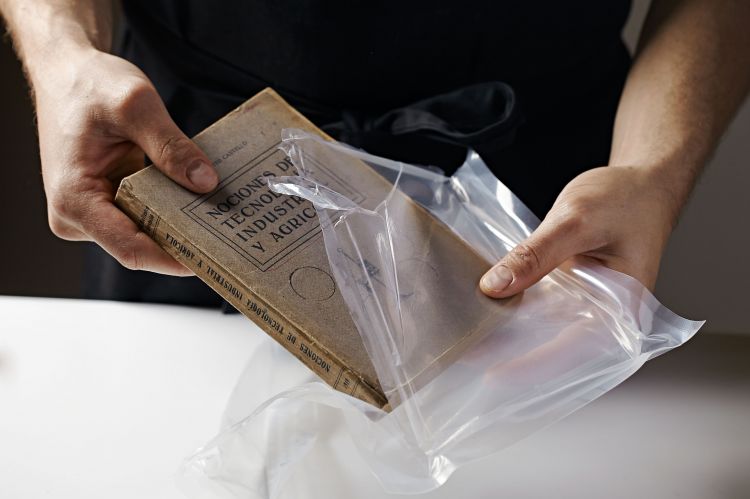
The various steps of the Roca techniques: take an old book...
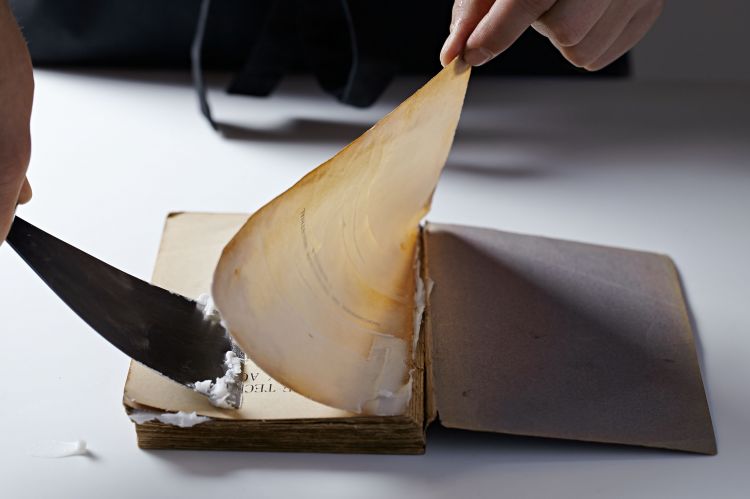
... brush the pages with a solid grease and let them rest...
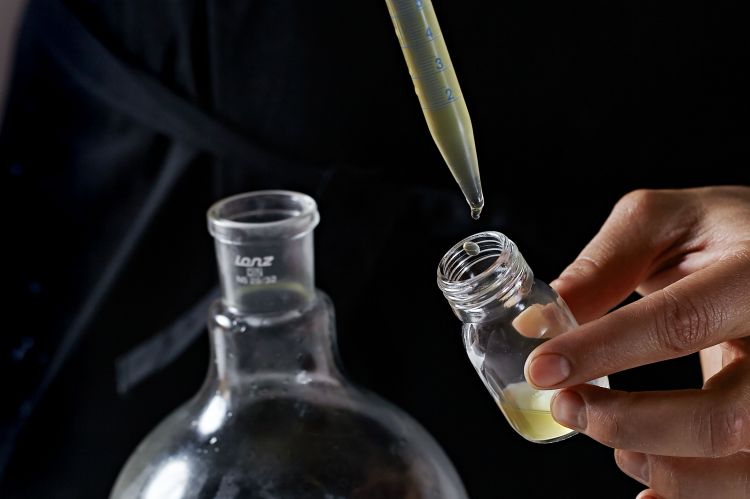
... finally, scrape the fat, drain it in alcohol, and distil it with the Rotaval. The essence of antique book is ready
This dual technique was first used in 2016 in
Oda al caldillo de congrio. Homenaje a Pablo Neruda, i.e.
Ode to conger eel soup, the title of a poem by
Pablo Neruda that became a dish: essentially a rewrite of a traditional Chilean recipe (coriander sprouts, purple oxalys, confit onion, diced conger eel, coriander and onion puree, conger eel broth) with the final touch of an edible rice paper, bearing
Neruda's words and flavoured with old book fragrance.
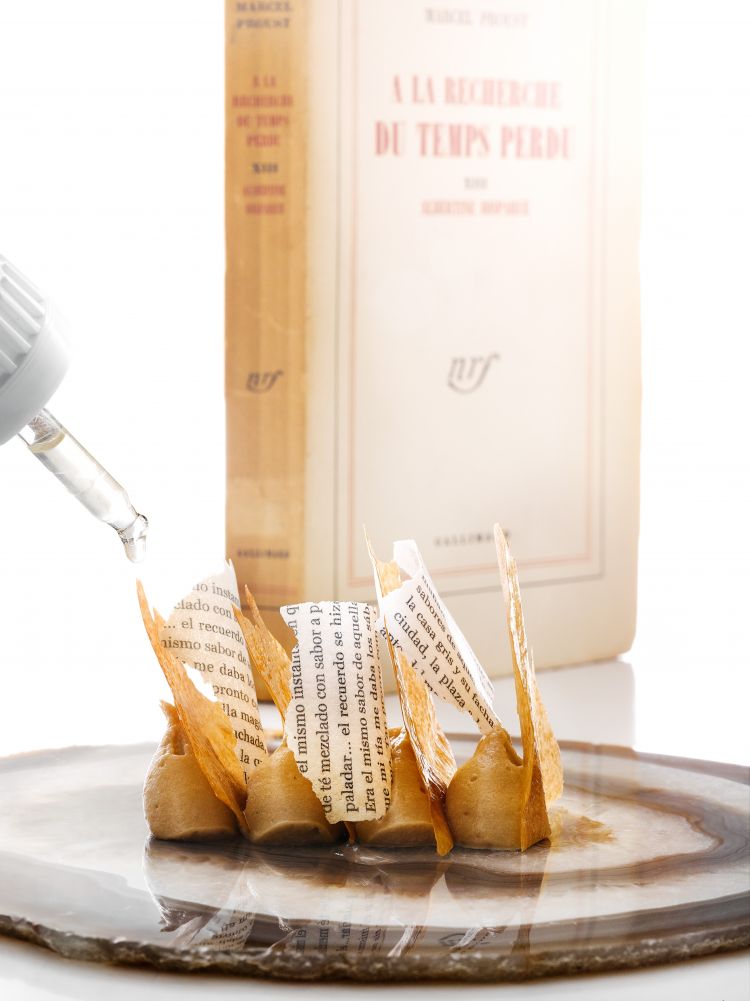
Milhojas de crema de té Earl Grey, helado de magdalenas, tejas de mantequilla caramelizadas y papel de arroz
Next, the
Rocas offered their
Celler a dessert,
Millefoglie with toasted butter, Darjeeling tea cream and essence of old book. Now they are taking that cue again, in a slightly modified soon-to-be-announced dessert:
Milhojas de crema de té Earl Grey, helado de magdalenas, tejas de mantequilla caramelizadas y papel de arroz, or
Millefoglie of Earl Grey tea cream, ice cream of magdalenas (similar to muffins)
, caramelised butter tiles and rice paper, which bears excerpts from
Marcel Proust's
In Search of Lost Time. And it is flavoured, of course, with the old book. 'A homage to the new encounter with literary moments',
Jordi called it.
Translated into English by Slawka G. Scarso